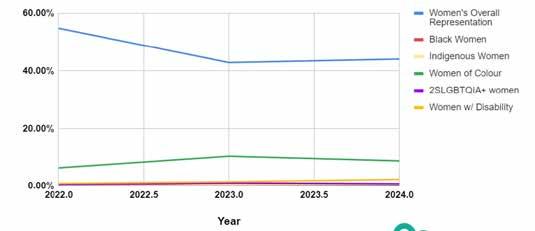International Women's Day
How do you believe women are currently paving the way in sports, and what role does female leadership play in this evolution?
In so many ways. I think that the growing involvement that women have in sports — from broadcasting to commentating to coaching to health therapists to athletes — is growing at such a rapid pace. Once women continue to see the possibilities, the more they can aspire to become one of these things. This leadership is super impactful but it is also impactful to understand that these women that are paving the way in what has been a male dominant field. These women are new in these environments and have
Mediaplanet sat down with professional athlete and Olympian Emma Maltais to discuss her journey in sport and how she's empowering Canada’s next generation of athletes!
to have many discussions and conversations to ensure that they are valued evenly amongst their peers.
Can you share a defining moment in your career that you believe showcases the impact women can have in sports?
I think in my career in particular was the experience I had with going to the Olympics and then also my involvement with the PWHL. At the Olympics, when the NHL players were not able to compete in the Olympics, it almost felt in the hockey world that all the attention was on us. The expectation and attention we got when we were able to win gold in Beijing is an example of how on the main sport stage of the Olympics, women can be at the centre. With the PWHL I also have felt that dramatically. The amount of attention we are getting once the broadcasting and the marketing evened out is exceptional. It shows that once the resources were evened out, that the attention was delivered the way we always thought it would be. To see the young girls with signs and the older women who are so invested in our league shows how much the impact matters and how inspiring it can be.
In your experience, how can sports contribute to empowering young girls and fostering a sense of leadership?
I think the way that young girls are inspired are
Breaking Barriers: A Female Tech CEO's Insights on Entrepreneurship, and the Future of Women in STEM
Mediaplanet sat down with Laurie Clark, entrepreneur and founder of Onyen Corporation, Canchek Corporation, and Smarten Up Institute, to share her story and educate Canadian's how they can better support women in STEM.
What advice would you give to other aspiring women in STEM?
To my fellow aspiring female entrepreneurs in STEM, I offer this counsel: Seek out supportive communities and mentors and immerse yourself in the stories of trailblazing women who have paved the way before us. Delve into the rich legacy of Canadian women in STEM, from luminaries like Mabel Bell and Elsie MacGill to modern-day icons like Donna Strickland and Vicky Kaspi. Their journeys inspire and illuminate the path forward, reminding us that greatness knows no gender. A great starting point would be to research these important women below: Harriet Brooks– she was the first Canadian female nuclear physicist. She made important contributions to the field of atomic physics and was the first woman to receive a master’s degree from McGill; Donna Strickland — a pioneering physicist, known for her work on ultrafast lasers. She has authored more than 90 publications and in 2018 was jointly awarded the Nobel Prize in Physics for her work; Ursula Franklin — who was
Canada needs individuals to whom educators can point, and of whom we can be proud, whether athletes or astronauts or anything else. I think the role each Canadian plays is not so much ‘Look at me,’ but rather, ‘Look at our country.’
— Roberta Bondar
a physicist, educator, feminist and social activist. She pioneered the development of archaeometry, which applies modern techniques of materials analysis to archaeology; Roberta Bondar — astronaut, neurologist, physician, space medicine research pioneer, and first Canadian woman (and second Canadian) in space.
Women in STEM make up only 24 per cent of the workforce. Why do you think women are so rarely seen in the tech space?
The glaring underrepresentation of women in the tech realm stems from a myriad of complex factors, but I'll pinpoint one area ripe for transformation — STEM education. We possess the tools and the talent to effect change, but our true potential lies in harnessing the collective brilliance of Canadian women across all levels of society. By fostering inclusivity and championing STEM education for women of every background, we can propel Canada to unparalleled heights of innovation and excellence.
in a lot of different ways that we don’t realize. For example, after the Scotiabank arena game a young girl came up to me and told me that I inspired her because of my size and how I still play with strength because she struggles with how small she is. Something so simple can inspire young girls to simply just not quit and to keep going. At the end of the day, I think this is the biggest thing. If young girls can continue to see the possibilities of what they can be and what avenues they can take to get there, maybe less quit at a young age, maybe more resources.
What advice do you have for young Canadian girls aspiring to excel in sports and possibly pursue a career in athletics? My biggest piece of advice would be to continue to have fun and enjoy what you do. With these new opportunities there can be even more pressure to perform but the more you can enjoy what you do, the more than you will be grateful for where you are and ultimately the better you will do. I think the more you are able to have fun putting in the effort to your dreams, the more the effort will turn into your craft which will uniquely propel you forward.
my employment and mentorship of women across continents, from North America to Africa to Europe.
What do you see as the future of women in the tech industry?
How do you and your businesses support women and girls in STEM?
My commitment to empowering women in STEM extends far beyond mere rhetoric. Through initiatives like the Smart Mentor Program and originally with the SUI Top Under 40 Award (now the IIAC Top Under 40 Award), I actively cultivate a culture of mentorship and recognition, ensuring that talent knows no gender or race boundaries. Moreover, by sponsoring initiatives like the Northern Secondary School robotics team, I seek to nurture the next generation of female STEM leaders, instilling in them the confidence and skills needed to thrive in a male-dominated industry. And on a global scale, my dedication to gender diversity remains unwavering,
The future of women in the tech industry is undeniably bright, marked by the meteoric rise of young trailblazers like Zainab Azim (a future astronaut) and Greta Thunberg (climate activist). However, our journey toward gender parity and leadership must be relentless. By championing initiatives like board diversity and leveraging compelling data on the superior performance of women-led companies, we can pave the way for a future where women occupy their rightful place at the helm of innovation and decision-making. My own experiences at the many companies I led, underscore the transformative power of gender diversity, proving that when women ascend to leadership positions, businesses thrive, and societies prosper.
Photo credit: Owen Mertens (@owen_mert on instagram)
Supporting Women Entrepreneurs Is Critical to Innovation, Growth and Sustainability
This year the Government of Canada’s theme for International Women’s Day (IWD) 2024 is Invest in women: Accelerate progress. It reminds us to double down on our investment in women entrepreneurs. Small- and medium-sized enterprises (SMEs) are the backbone of our economy and women are playing an increasingly important role — now accounting for almost 20 per cent of business owners. Our economic, innovation, and training strategies need to focus on SMEs because they account for 90 per cent of private sector employment in Canada compared to only 50 percent in the USA. We need to invest in startups but also help them to scale up. Women-owned businesses contribute to growth and innovation closing the gender gap in entrepreneurship could boost GDP by up to $150 million — but they also drive our transition to net zero and our commitments to sustainable development goals.
Canada already has a first-in-the-world $7-billion Women Entrepreneurship Strategy which is increasing investments, building the ecosystem and prioritizing data driven
approaches. It also offers a whole of government approach leveraging policies, procurement and programs across all departments to support women entrepreneurs.
But we need to ensure that the entire innovation and entrepreneurship ecosystem doesn’t present barriers to ventures led by women and other equity-deserving groups.
Culture and stereotypes play a powerful role — when people think of entrepreneurs they often think of men and tech. Because women entrepreneurs are less likely to be in tech and more likely to be in services and because they have smaller and under-financed businesses, they are often not considered in the design of programs and policies.
More than half of businesses in Canada start with less than $5000 but getting $5000 remains a massive challenge. Innovative programs have demonstrated that new approaches to assessing risk and financing women entrepreneurs can result in higher returns and lower default rates. However, women tend to get the short shrift: identical pitches by men and women produce radically different results. Programs targeting women often have much higher interest rates (10 per
cent or more) because they are encumbered by traditional approaches to assessing risk. Despite the growing number of programs offered for women by financial institutions, angel investors and venture capitalists, we need better data. In the UK, the Investing in Women Code encourages setting targets and transparency which can help nudge even large institutions towards fairer practices. We need to rethink many of the fundamentals. Innovation is not just about technology — it’s actually about doing differently. Canada desperately needs entrepreneurs who build technology, but even more, we need entrepreneurs who can drive changes in the adoption of new products, services, and processes. We need people who can shape organizational and human behaviour whether in ICT or green tech. When we think more broadly about economic development, innovation, and sustainability the critical importance of women entrepreneurs becomes clearer. It's important to celebrate their achievements across sectors — to shape aspirations and normalize women entrepreneurship — because if you can see it, you can be it.
The Prosperity Project: How to Fix the Scarcity of Women in the Pipeline to Leadership
Julie Savard-Shaw
2022
The Prosperity Project (TPP), incepted in April 2020, was conceived to mitigate the impacts of the COVID-19 pandemic on women in Canada. In 2023, we turned our attention to identifying and eliminating the entrenched barriers and biases that impede women’s advancement, limiting their, and Canada’s, opportunities for increased prosperity.
Our Annual Report Card on Gender Diversity and Leadership (ARC) is the only annual diversity study in Canada that measures intersectional gender-disaggregated data at four different levels of leadership.
What does that mean? We look at the number of Black women, Indigenous women, women of colour, women identifying as having a disability, and 2SLGBTQIA+ women at each of these
levels: pipeline to senior management, senior management, executive officer, and corporate director.
An alarming trend is surfacing: the pipeline of women in Canada moving toward leadership roles has not recovered since the drastic drop during COVID-19.
Why? Many women in corporate Canada don’t see the benefits of seeking advancement. Our Canadian Households’ Perspective surveys show that women are plagued by burnout and stress, but most importantly, they feel undervalued, unsupported, passed over for promotions, and underpaid compared to their male counterparts.
In 5 to 10 years, who will be sitting around your decision-making table? It’s time companies invest in women to accelerate progress.
Thank you to our partners.
Perspective surveys show that women are plagued by burnout and stress, but most importantly, they feel undervalued, unsupported, passed over for promotions, and underpaid compared to their male counterparts.
Julie Savard-Shaw Executive Director,
The Prosperity Project
Q&A WITH Kathleen Taylor
Founding Visionary, The Prosperity Project
Why is knowing the representation of women in the pipeline to leadership important?
Research shows that greater representation of women in senior leadership leads to increased performance and higher profitability. When organizations have a solid understanding of who is in — or could be in — the pipeline for leadership roles, they can actively develop and promote more high-potential female candidates, helping to ensure that these women are prepared and supported as they move toward and into the top positions.
How can organizations help women in the pipeline to leadership advance to senior leadership roles?
Women's overall representation in the pipeline to senior management has dropped by 10% since 2022.
Today’s decision-makers can support the advancement of women to senior positions by modernizing systems that historically may have promoted men over women. To do that, organizations need to monitor, cultivate, and actively develop women in their leadership pipelines. At the same time, women must be offered and encouraged to accept operational roles that put them on the succession track for the C-suite. All of this requires a hands-on approach to foster a culture where women can access the support and mentorship that are critical to their success. While no easy feat, a concerted effort in this space has increased the representation of women in senior leadership roles across many sectors and businesses.
- 2024 Gender and Diversity Representation in Pipeline to Senior Management Role
Wendy Cukier
Wendy Cukier
Looking for WomenCentric Support? Call This Helpline and Get Connected
ConnexOntario works to help women through every phase of life by connecting them with addiction and mental health community supports and services.
Katherine Cappellacci
When a woman needs help, there are barriers that may hinder her from reaching out. The societal pressure put upon today’s women can inhibit them from getting appropriate care.
These pressures are everywhere, from subconsciously engrained biases to outward-facing barriers. For example, sometimes the fear of being perceived as a bad parent may stop a woman from seeking professional mental health or addiction treatment. Women are impacted by societal expectations, beauty standards, and may feel too ashamed to ask for help. Women are also more likely have their feelings or symptoms dismissed by health care professionals.
Plus, a woman’s experience is also impacted by their age, racial background, sexual orientation, and more. Therefore, there’s a great need for women-focused services that take these many factors into account.
Compassionate, personalized
assistance
ConnexOntario is heeding the call –they’re helping women in Ontario get connected with services that is uniquely catered to their needs. An information referral helpline, they ensure that any person can get access to the appropriate support they require.
With services that are confidential and covered by OHIP, ConnexOntario maintains a centralized focus on community support and care. This is reflected in their database, which is a compilation of organizations with whom they have built personal partnerships. By working in collaboration with many local operators, they put callers in touch with resources that are close by and accessible, provide basic education about addiction or mental health, and offer support.
When someone calls the helpline, they can be connected to support that’s specific to their individual situation. In fact, their database includes more than 1013 addiction and mental health pro -
Opening Doors: CCWESTT
Neemee Batstone believes representation is critical for women to see a place for themselves in STEM. CCWESTT
As an Op Ex Project Manager Associate at StandardAero, Neemee Batstone works in a male-dominated space.
Batstone is Past-President of the Canadian Coalition of Women in Engineering, Science, Trades and Technology (CCWESTT) Board, participates in StandardAero’s Employment Equity Committee, and represents Engineers Geoscientists Manitoba in Engineers Canada’s 30 by 30 initiative.
Mentorship matters
Working as an engineer and volunteering in this space has given her insight into systemic changes that would increase gender equity in workplaces. Many of her mentors have been men who were well-respected in their fields. Batstone says organizations need to encourage mentorship over metrics, regardless of the mentor’s gender.
The importance of representation
“I see this huge door open for any female and they’re just not taking it,” Batstone says. “I feel like I need to be a part of exposing these opportunities and opening doors because those privileges have been given to me. I need to represent because if people can see that I can do it, I’m hoping they can see that they can, too.”
A community conference
Batstone says it’s easy to stay involved with her volunteer work because of the network she’s built. The sharing of stories at events like the CCWESTT’s biennial conference builds a strong community and fuels the action toward change. “What you don’t know before you go to a CCWESTT conference is the amount of synergy and connections,” Neemee says. “You need to make these connections for job opportunities or friendship. You need to experience it.”
Women are impacted by societal expectations, beauty standards, and may feel too ashamed to ask for help. Women are also more likely have their feelings or symptoms dismissed by health care professionals.
grams that are specialized to the needs of women.
Wide-ranging resources
Some resources for women may include support for postpartum depression, transitional housing options, addiction or withdrawal support, and more. There are approximately 80 community-based substance abuse treatment options for women in the database.
There are also services specialized towards supporting pregnant and parenting women. These include prenatal mental health services, early child development programs in substance use categories, and many other mental health and addiction services that support the different phases of a woman’s life.
ConnexOntario is giving women of all ages the tools to thrive throughout every stage of life. By providing individualized care to anyone who reaches out to them for help with mental health or addiction, they are committed to uplifting women and their respective communities across the province.
SCWIST’s New Project Tackles Gender-Based Violence
in STEM Workplaces
The Society for Canadian Women in Science and Technology is launching a groundbreaking project aimed at mitigating gender-based violence in STEM workplaces.
Gender-based violence (GBV) in science, technology, engineering, and mathematics (STEM) workplaces is a pervasive issue that hinders the advancement and well-being of women and gender-diverse individuals.
GBV can range from subtle forms of bias and discrimination to overt acts of violence and sexual harassment. The hostile environment created by such behaviours undermines individual careers and perpetuates gender disparities within STEM fields.
The Society for Canadian Women in Science and Technology (SCWIST)'s new project seeks to address these systemic issues head on by scaling multiple promising practices, such as engaging men to address hierarchical power issues and guided discussions to build empathy and cognitive-behavioural changes. The ultimate goal is to create environments where the spectrum of GBV is recognized and not tolerated. This project will address the intersectional needs of equity-deserving groups, including youth, Indigenous Peoples, Black people, racialized people, newcomers, and members of the 2SLGBTQ+ community, across Canada.
Addressing and preventing GBV STEM companies and professional associations that participate in the project will receive workplace training, processes, policy recommendations, and resources. A comprehensive knowledge-sharing strategy will help the SCWIST, collaboration partners, and other networks to share resources and tools to expand the impact of the project.
“Addressing and preventing GBV in the workplace will ensure that women and gender-diverse individuals are safe, welcome, valued, and productive,” says SCWIST President Dr. Melanie Ratnam. “We’re creating the environment to ensure that society can fully benefit from diversity, innovation, and creative solutions from STEM sectors to contribute to Canada’s prosperity.”
Ultimately, this project represents a significant step toward achieving gender equity and inclusion in STEM workplaces. By addressing the root causes of GBV and promoting cultural change, we can build a future where all individuals, regardless of gender, can thrive and succeed in STEM fields.
Dr. Melanie Ratnam President, SCWIST
























